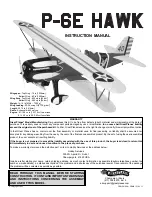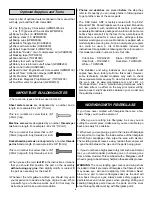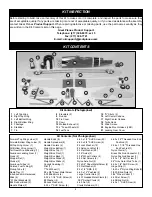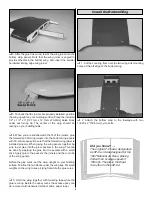
❏
1. If you have not done so already, remove the major parts
of the kit from the box and inspect for damage. If any parts
are damaged or missing, contact Product Support at the
address or telephone number listed in the “Kit Inspection”
section on page 5.
❏
2. Remove the tape and separate the ailerons from the
wing and the elevators from the stab. Use a covering iron
with a covering sock on high heat to tighten the covering if
necessary. Apply pressure over sheeted areas to thoroughly
bond the covering to the wood.
Do the right top wing first, so your work matches the
photos the first time through. You can do one wing at a
time, or work on them together.
❏ ❏
1. On the right top wing panel, drill a 3/32" [2.4mm]
hole, 1/2" [13mm] deep in the center of each hinge slot to
allow the CA to “wick” in. Follow-up with a #11 blade to clean
out the slots. Hint: If you have one, use a high-speed rotary
tool to drill the holes.
❏ ❏
2. Use a sharp #11 blade to cut a strip of covering
from the hinge slots in the wing and aileron.
❏ ❏
3. Cut four 3/4" x 1" [19 x 25mm] hinges from the CA
hinge strip. Snip off the corners so they go in easier.
❏ ❏
4. Test fit the ailerons to the wing with the hinges. If
the hinges don’t remain centered, stick a pin through the
middle of the hinge to hold it in position.
❏ ❏
5. Remove any pins you may have inserted into the
hinges. Adjust the aileron so there is a small gap between the
LE of the aileron and the wing. The gap should be small, just
enough to see light through or to slip a piece of paper through.
❏ ❏
6. Apply six drops of thin CA to the top and bottom of
each hinge. Do not use CA accelerator. After the CA has
fully cured, test the hinges by pulling on the aileron.
❏
7. Repeat steps 1- 6 for the left top wing panel.
3/4"
[20mm]
1"
[25mm]
Installing the Ailerons
BUILD THE WINGS
PREPARATIONS
7








































